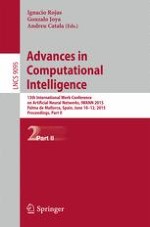This two-volume set LNCS 9094 and LNCS 9095 constitutes the thoroughly refereed proceedings of the 13th International Work-Conference on Artificial Neural Networks, IWANN 2015, held in Palma de Mallorca, Spain, in June 2013. The 99 revised full papers presented together with 1 invited talk were carefully reviewed and selected from 195 submissions. The papers are organized in topical sections on brain-computer interfaces: applications and tele-services; multi-robot systems: applications and theory (MRSAT); video and image processing; transfer learning; structures, algorithms and methods in artificial intelligence; interactive and cognitive environments; mathematical and theoretical methods in fuzzy systems; pattern recognition; embedded intelligent systems; expert systems; advances in computational intelligence; and applications of computational intelligence.
